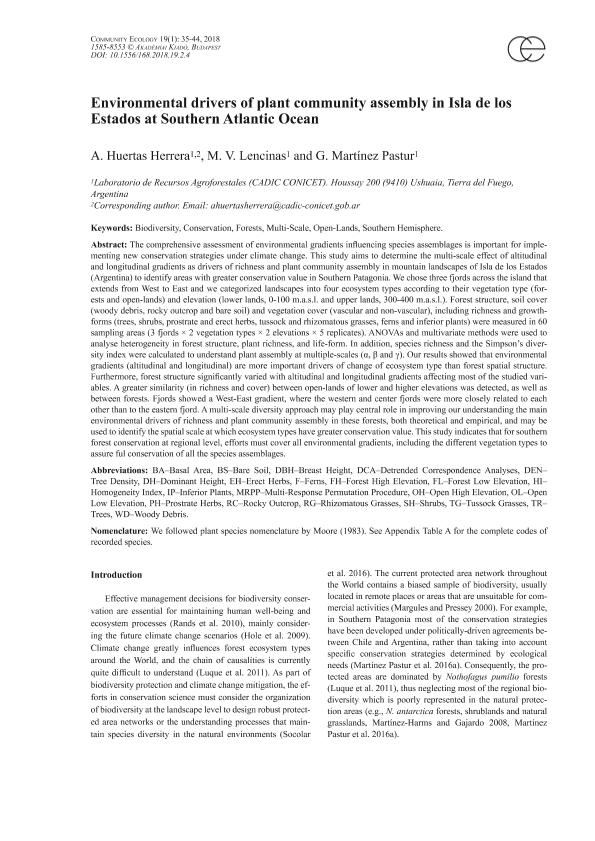Mostrar el registro sencillo del ítem
dc.contributor.author
Huertas Herrera, Alejandro

dc.contributor.author
Lencinas, María Vanessa

dc.contributor.author
Martínez Pastur, Guillermo José

dc.date.available
2019-10-21T22:14:07Z
dc.date.issued
2018-06
dc.identifier.citation
Huertas Herrera, Alejandro; Lencinas, María Vanessa; Martínez Pastur, Guillermo José; Environmental drivers of plant community assembly in Isla de los Estados at Southern Atlantic Ocean; Akadémiai Kiadó; Community Ecology; 19; 1; 6-2018; 35-44
dc.identifier.issn
1585-8553
dc.identifier.uri
http://hdl.handle.net/11336/86783
dc.description.abstract
The comprehensive assessment of environmental gradients influencing species assemblages is important for implementing new conservation strategies under climate change. This study aims to determine the multi-scale effect of altitudinal and longitudinal gradients as drivers of richness and plant community assembly in mountain landscapes of Isla de los Estados (Argentina) to identify areas with greater conservation value in Southern Patagonia. We chose three fjords across the island that extends from West to East and we categorized landscapes into four ecosystem types according to their vegetation type (forests and open-lands) and elevation (lower lands, 0-100 m.a.s.l. and upper lands, 300-400 m.a.s.l.). Forest structure, soil cover (woody debris, rocky outcrop and bare soil) and vegetation cover (vascular and non-vascular), including richness and growth-forms (trees, shrubs, prostrate and erect herbs, tussock and rhizomatous grasses, ferns and inferior plants) were measured in 60 sampling areas (3 fjords × 2 vegetation types × 2 elevations × 5 replicates). ANOVAs and multivariate methods were used to analyse heterogeneity in forest structure, plant richness, and life-form. In addition, species richness and the Simpson's diversity index were calculated to understand plant assembly at multiple-scales (α, β and γ). Our results showed that environmental gradients (altitudinal and longitudinal) are more important drivers of change of ecosystem type than forest spatial structure. Furthermore, forest structure significantly varied with altitudinal and longitudinal gradients affecting most of the studied variables. A greater similarity (in richness and cover) between open-lands of lower and higher elevations was detected, as well as between forests. Fjords showed a West-East gradient, where the western and center fjords were more closely related to each other than to the eastern fjord. A multi-scale diversity approach may play central role in improving our understanding the main environmental drivers of richness and plant community assembly in these forests, both theoretical and empirical, and may be used to identify the spatial scale at which ecosystem types have greater conservation value. This study indicates that for southern forest conservation at regional level, efforts must cover all environmental gradients, including the different vegetation types to assure ful conservation of all the species assemblages.
dc.format
application/pdf
dc.language.iso
eng
dc.publisher
Akadémiai Kiadó

dc.rights
info:eu-repo/semantics/openAccess
dc.rights.uri
https://creativecommons.org/licenses/by-nc-sa/2.5/ar/
dc.subject
BIODIVERSITY
dc.subject
CONSERVATION
dc.subject
FORESTS
dc.subject
MULTI-SCALE
dc.subject
OPEN-LANDS
dc.subject
SOUTHERN HEMISPHERE
dc.subject.classification
Otras Agricultura, Silvicultura y Pesca

dc.subject.classification
Agricultura, Silvicultura y Pesca

dc.subject.classification
CIENCIAS AGRÍCOLAS

dc.title
Environmental drivers of plant community assembly in Isla de los Estados at Southern Atlantic Ocean
dc.type
info:eu-repo/semantics/article
dc.type
info:ar-repo/semantics/artículo
dc.type
info:eu-repo/semantics/publishedVersion
dc.date.updated
2019-10-17T14:14:42Z
dc.identifier.eissn
1588-2756
dc.journal.volume
19
dc.journal.number
1
dc.journal.pagination
35-44
dc.journal.pais
Hungría

dc.journal.ciudad
Budapest
dc.description.fil
Fil: Huertas Herrera, Alejandro. Consejo Nacional de Investigaciones Científicas y Técnicas. Centro Austral de Investigaciones Científicas; Argentina
dc.description.fil
Fil: Lencinas, María Vanessa. Consejo Nacional de Investigaciones Científicas y Técnicas. Centro Austral de Investigaciones Científicas; Argentina
dc.description.fil
Fil: Martínez Pastur, Guillermo José. Consejo Nacional de Investigaciones Científicas y Técnicas. Centro Austral de Investigaciones Científicas; Argentina
dc.journal.title
Community Ecology

dc.relation.alternativeid
info:eu-repo/semantics/altIdentifier/url/https://www.akademiai.com/doi/10.1556/168.2018.19.1.4
dc.relation.alternativeid
info:eu-repo/semantics/altIdentifier/doi/https://doi.org/10.1556/168.2018.19.1.4
Archivos asociados
